Odisha State Board CHSE Odisha Class 11 Biology Solutions Chapter 2 Classification of Living World Textbook Questions and Answers.
CHSE Odisha 11th Class Biology Chapter 2 Question Answer Classification of Living World
Classification of Living World Class 11 Questions and Answers CHSE Odisha
A. Very Short Answer Type Questions
Fill in the blanks choosing appropriate answers given in the brackets.
Question 1.
In two kingdom system of classification _______ were ignored. (eukaryotes, plants, prokaryotes, animals)
Answer:
Prokaryotes
Question 2.
The major component of the cell wall of bacteria is _______. (peptidoglycan, cellulose, chitin, lipoprotein)
Answer:
Peptidoglycan
Question 3.
The core of the viruses are composed of _______ .(protein, carbohydrate, vitamins, nucleic acid)
Answer:
Nucleic acid
Question 4.
Fungi have _______ mode of nutrition. (absorptive, ingestive, autotrophic, epiphytic)
Answer:
Absorptive
Question 5.
Viruses are living because they grow and _______(respire, reproduce, recognise hosts, transmissible)
Answer:
Reproduce
Choose the correct answer from the words given in the brackets.
Question 6.
In two kingdom system, the status of one of the following type of organisms was ignored.
(Fungi, Bacteria, Bryophytes, Pteridophytes)
Answer:
Bacteria
Question 7.
Three-kingdom system of classification was proposed by
(Haeckel, Linnaeus, Whittaker, Copeland).
Answer:
Haeckel
Question 8.
One of the following components of viruses penetrate into the host cell
(protein, capsid, nucleic acid, carbohydrates)
Answer:
Nucleic acid
Question 9.
The character which separates plants from animals is the occurrence of (ribosome, nucleus, mitochondria, cell wall)
Answer:
Cell wall
Question 10.
Fungi show one of the following types of nutrition.
(Autotrophic, absorptive, ingestive, swallowing)
Answer:
Absorptive
B. Short Answer Type Questions
Write notes in 2 to 3 relevant and meaningful points.
Question 1.
Two kingdom system of classification
Answer:
Two Kingdom Classification System
Linnaeus (the father of taxonomy) divided all the living organisms into two kingdoms in 1758. These are Plantae and Animalia.
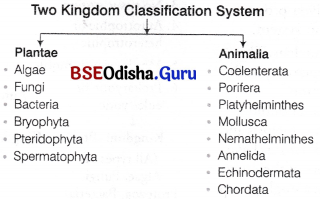
Question 2.
Three kingdom system of classification
Answer:
Three Kingdom Classification System
Ernst Haeckel in 1866, classified living organisms into three kingdoms – Plantae, Protista and Animalia. The new kingdom – Protista included all those organisms which lack the capability of tissue differentiation. These are algae, fungi, protozoans, bacteria and slime moulds. Later, kingdom – Protista was reserved only for unicellular organisms.
An outline of three kingdom system of classification is given below
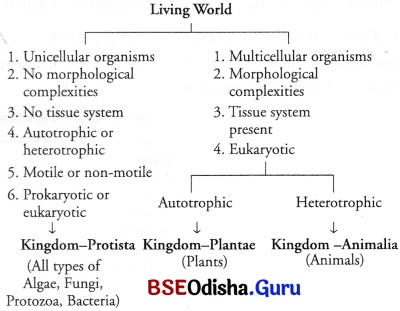
Question 3.
Characteristic features of algae.
Answer:
Characteristic Features of Algae
- Algae are simple , thalloid, chlorophyll bearing (green), autotrophic and largely aquatic (both freshwater and marine) plant.
- Algae reproduce by vegetative, asexual and sexual methods.
- Their size ranges from unicellular microscopic forms like Chlamydomonas to colony forming forms Volvox and to filamentous forms like Ulothrix and Spirogyra.
Question 4.
Characteristic features of fungi.
Answer:
Characteristic Features of Fungi
- Fungi are uni or multicellular-achlorophyllous, spore bearing thallophytes.
- Their cell wall is made up of chitin.
- These are heterotrophic, may be saprophytic or parasitic.
- Fungi are generally multicellular, thread-like structures, branched in various patterns called mycelia. These constitute the thallus. Its individual branches are called hypha.
Question 5.
Viruses, as living beings
Answer:
Viruses are intermediate between living and non-living objects.
They resemble non-living objects in
- Lacking protoplast.
- Ability to get crystallised.
- High specific gravity which is found only in non-living objects.
- Absence of respiration and energy storing system.
- Absence of growth and division.
- Cannot live independent of a living cell.
They resemble living objects in
- Presence of genetic material (DNA or RNA).
- Capable of mutation.
- Irritability.
- Can grow and multiply inside the host cell.
Question 6.
Mycoplasma
Answer:
Mycoplasma are organisms that completely lack a cell wall. They were discovered by Roux (1898) in pleural fluid of cattle suffering from pleuropneumonia. The organisms are often called PPLOs (Pleuropneumonia Like Organisms).
The characteristic features of mycoplasma are given below
- Mycoplasmas are the smallest (0.1-0.5 μm) free-living microorganisms that are so small that they can easily pass through bacteria-proof filters. These occur saprotrophically in soil, sewage water and in dead and decaying organic matter. Some of them also parasitise plants, animals and human beings. Pathogenic mycoplasmas cause diseases in their hosts.
- They are unicellular with plasma membrane as the outermost boundary. The cell membrane is made up of protein, lipids and cholesterol.
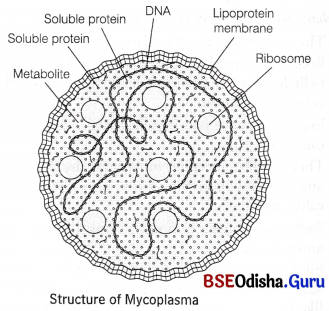
Structure of Mycoplasma - DNA is naked (because of the absence of histones) and ribosomes of 70S type are present.
- Mycoplasmas possess heterotrophic nutrition. Examples are Mycoplasma gallisepticum, M. laidlawii. They cause pleuropneumonia in domestic animals, mycoplasmal urethritis in humans.
- These can survive without oxygen.
Question 7.
Phycomycetes
Answer:
The members of Phycomycetes are found in aquatic habitats and on decaying wood in moist and damp places or as obligate parasites on plants. Phycomycetes can be distinguished into two sub-classes, i.e. Zygomycetes (saprophytic) and oomycetes (plant parasites).
General characteristics of phycomycetes are as follows
- Mycelium is aseptate and coenocytic.
- Hyphal wall contains microfibrils of cellulose, chitin or both.
- Asexual reproduction involves the endogenous formation of sporangia. The sporangia function as conidia in dry habitats and as zoosporangia under wet conditions.
- Zoospores may be uniflagellate or biflagellate with flagella being anterior, lateral or posterior. A zoospore is formed by the fusion of two gametes.
- The gametes can be similar in morphology (isogamous) or dissimilar (anisogamous or oogamous).
- Disease caused by the members of Phycomycetes are white rust (Albugo), late blight of potato (Phytophthora infestans), downy mildew (Peronospora parasitica), etc.
Examples include oomycetes Albugo (parasitic fungi on mustard), Pythium, Plasmospara, Phytophthora. Zygomycetes Rhizopus (the bread mould), Mucor (pin mould), etc.
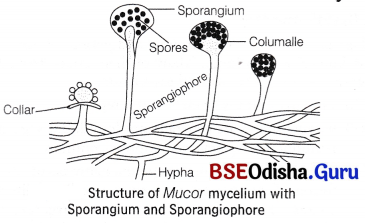
Differentiate in 2 to 3 relevant meaningful points.
Question 1.
Prokaryotes and Eukaryotes
Answer:
Differences between prokaryotes and eukaryotes are
| Prokaryotes | Eukaryotes |
| No membrane bound nucleus. | Have nucleus with nuclear membrane, chromatin, nucleoplasm, nuclear matrix and nucleoli. |
| Cell walls made up of peptidoglycan. | Cell walls, if present, made up of cellulose (as in fungi). |
| No membrane bound organelles. | Membrane bound organelles present. |
| Have pilli and fimbriae (for adhesion) and flagella (for propulsion). | Have cilia or flagella (for movement). |
| Cell size ranges from 0.5μ.m – 100μm | Cell size ranges from 10μ.m – 150μm |
Question 2.
Protista and Monera
Answer:
Differences between Protista and Monera are
| Monera | Protista |
| Cell wall is made up of peptidoglycan. | It is made up of cellulose. |
| Respiratory apparatus is present in respiratory membrane. | It is present in mitochondria. |
| Ribosomes are 70S type. | Ribosomes are 80S type. |
| These are prokaryotic and have naked circular DNA. | Eukaryotic, linear DNA is present in nucleus. |
| Extrachromosomal DNA is present in the form of plasmids. | Extrachromosomal DNA is present in organelles like mitochondria and chloroplast. |
Question 3.
Mycota and Planate
Answer:
Differences between Mycota and Planate are
| Mycota (Fungi) | Plantae |
| They are eukaryotic, unicellular or multicellular organisms with chitinous cell wall. | They are eukaryotic, multicellular organisms with cellulosic cell wall. |
| The members of this kingdom do not possess photosynthetic pigments and are therefore heterotrophic. | The members of the Plantae group contain photosynthetic pigment ’ and gain their energy through it and are therefore autotrophic. |
| They have few or no storage molecules. | Starch is their main storage molecule. |
Question 4.
Amoeboid protozoans and ciliated protozoans
Answer:
Differences between amoeboid protozoans and ciliated protozoans are
| Amoeboid protozoans | Ciliated protozoans |
| Protozoans with false feet or pseudopodia which moves by amoeboid movement, accomplished by cytoplasmic streaming. | Protozoans that move using cilia by ciliary movement. (like Paramecium) |
| Ingest food by phagtocytosis. | Ingest food through oral groove covered by cilia. |
| Reproduction by binary fission. | Reproduction by binary fission or conjugation. |
Question 5.
Archaebacteria and Eubacteria
Answer:
Differences between Archaebacteria and Eubacteria are
| Archaebacteria | Eubacteria |
| Peptidoglycan is absent in cell wall. It is made up of cellulosic carbohydrate. | Ceil wall is made up of peptidoglycans. |
| It is a single layer of branched chain lipids. | Plasma membrane consists of phospholipids. |
| Genes are interrupted by introns like eukaryotes. | Genes are not interrupted by non-coding zones or introns. |
C. Long Answer Type Questions
Question 6.
Give an account of five-kingdom system of classification. Add a note on its merits and demerits.
Answer:
Five Kingdom Classification System:
This classification system was proposed by RH Whittaker in 1969. Before 1969, the classification systems for the living organisms had undergone several changes over time.
In this classification Whittaker introduced Fungi, as a separate kingdom along with Monera, Protista, Plantae and animals.
The main criteria for classification used by Whittaker is
(i) Cell structure
(ii) Mode of nutrition
(iii) Thallus organisation
(iv) Reproduction
(v) Phylogenetic relationships
Merits of Five Kingdom Classification System:
Merits of five kingdom classification system are
(i) Euglena and other transition types which had been included both amongst plants and animals are given proper place under kingdom-Protista.
(ii) Fungi have their own biochemical, physiological and structural organisation. They have never been related to plants. In this system of classification, fungi are separately placed.
(iii) A separate kingdom-Monera including prokaryotes has been created. Monerans differ from all other organisms in their cellular, reproductive and physiological organisations.
(iv) The five kingdom classification system is based on cellular organisation, the mode of nutrition and complexity of structure. These were the basic factors used in earliest two kingdom system of classification.
(v) This system of classification was also based on origin and evolution of the organisms hence, phylogenetic one.
(vi) The plant and animal kingdoms are more homogenous than they were in the two kingdom system of classification.
Demerits of Five Kingdom Classification System:
Demerits of five kingdom classification system are
(i) Animal protozoans have been included in kingdom-Protista, which also includes unicellular plants. They show different modes of nutrition.
(ii) Chlorella and Chlamydomonas, though unicellular are included under the kingdom-Plantae. They should be kept in Protista.
(iii) Euglena like organisms and slime moulds with flexible life style may need the creation of an intermediate kingdom other than Protista.
(iv) Viruses and viroids are not kept in proper place in this system.
(v) Lichens have also not been placed in this system.
(vi) All groups are polyphyletic and not monophyletic in origin as underlined by this classification.
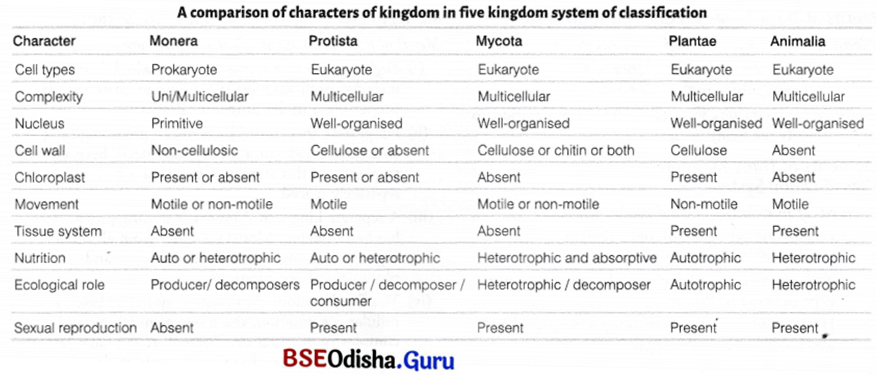
Question 7.
Give characteristic features of members of five kingdoms that were proposed by RH Whittaker.
Answer:
The five kingdom classification system classify all the living organisms into five kingdoms named Monera, Protista, Fungi, Plantae and Animalia.
The important characteristics of each kingdom are as follows
Kingdom-Monera:
The kingdom-Monera includes all prokaryotes such as bacteria, mycoplasmas, Actinomycetes and cyanobacteria (blue-green algae).
The characteristic features of kingdom-Monera are given below
(i) They are simplest and most primitive, unicellular prokaryotes.
(ii) The cell wall contains peptidoglycan or murein (no cellulose), but the membrane bound cell organelles are not present.
(iii) They have various types of modes of nutrition like saprophytic, parasitic, chemoautotrophic, photoautotrophic and symbiotic.
(iv) DNA is naked and it lies inside the cytoplasm in coiled form. This is called nucleoid or false nucleus.
(v) Reproduction is by asexual methods. Gametes are not present.
(vi) Mitotic spindle is absent.
(vii) The flagella, if present, are single-stranded instead of being several stranded as in eukaryotes. These contain a protein called flagellin.
(viii) Some of the monerans have the ability to fix nitrogen into useful nitrates.
Kingdom-Protista:
Kingdom-Protista includes all single-celled eukaryotes, but the boundries of this kingdom are not well-defined. This kingdom was first proposed by Ernst Haeckel (1866).
Physiologically, kingdom-Protista acts as a connecting link between the kingdom-Monera and the complex multicellular kingdoms-Fungi, Plantae and Animalia. Kingdom-Protista includes the following categories such as dinoflagellates, chrysophytes, euglenoids, slime moulds and protozoans. The general characteristic features of kingdom-Protista are given below
1. These are mostly aquatic organisms. Some protists also live in the bodies of animals as parasites.
2. The cells are eukaryotic. These contain all membrane bound cell organelles like mitochondria, Golgi complex, endoplasmic reticulum, 80 S ribosomes, etc. Cell wall when present is constituted by cellulose.
3. Locomotion may either occur by pseudopodia (Amoeba, Euglypha), cilia (Paramecium), wriggling (sporozoans, non-flagellates) and mucilage propulsion (some protists like diatoms). Diatoms do not have any organelle for locomotion.
4. Protists show various modes of nutrition such as
• Photosynthetic (Holophytic) Dinoflagellates, diatoms and euglenoids.
• Holozoic (Zootrophic) Protozoans like Amoeba and Paramecium.
• Saprobic (Saprotrophic) In slime moulds.
• Parasitic Trypanosoma, Giardia, Plasmodium, Entamoeba.
• Mixotrophic In Euglena.
• Symbiotic In zooflagellates like
Trichonympha and Lophomonas.
• Pinocytosis In Amoeba to absorb soluble organic substances.
5. Most of the protists are aerobic. However, some protists that live at the bottom of aquatic habitats can respire anaerobically.
6. Protists reproduce asexually and sexually by a process involving cell fusion and zygote formation.
The major groups of Protista are
(a) Protistan algae (photosynthetic protists).
(b) Slime moulds (consumer-decomposer protists).
(c) Protozoan protists.
Kingdom-Fungi or Mycota:
(i) These are uni or multicellular, achlorophyllous, spore bearing thallophytes.
(ii) Cell wall consists of cellulose or chitin or both.
(iii) In most cases, multicellular, thread-like structures, branched in various patterns are called mycelia. These constitute the thallus. Individual branches of it are called hypha.
(iv) These are heterotrophic, may be saprophytic or parasitic.
(v) Mode of nutrition is absorptive which means the enzymes secreted by the hyphae digest complex nutrients of the host. The simplified nutrients are then absorbed by the organisms.
(vi) The reproduction may be vegetative, asexual and sexual. Asexual reproduction takes place under favourable conditions.
(vii) The reserve food materials are glycogen, e.g. Aspergillus, Penicillium, Saccharomyces (yeast).
Kindom-Plantae:
(i) It includes mainly multicellular, eukaryotic and autotrophic organisms.
(ii) The major component of the cell wall is cellulose.
(iii) The cells contain few large vacuoles and no structure like centrosome.
(iv) These organisms are also called producers.
(v) The reserve food material is generally starch.
(vi) Growth in higher plants is always terminal.
(vii) The trees generally grow being fixed to the soif
(viii) Reproduction may be vegetative, asexual or sexual,
e.g. multicellular algae, bryophytes, pteridophytes, phanerogams.
Kingdom-Animalia:
Animal kingdom contains heterotrophic, eukaryotic organisms that are multicellular and their cells lack cell walls. The main source of food for animal kingdom are plants directly or indirectly.
The food is digested in alimentary canal and is reserved as glycogen or fat. The mode of nutrition is holozoic, i.e. by ingestion of food.
A definite growth pattern is present. Adults have definite shape and size. The higher forms have well-developed sensory and neuromuscular mechanism. Locomotion is present.
Sexual reproduction occurs by copulation followed by fertilisation of gametes and embryonic development.
